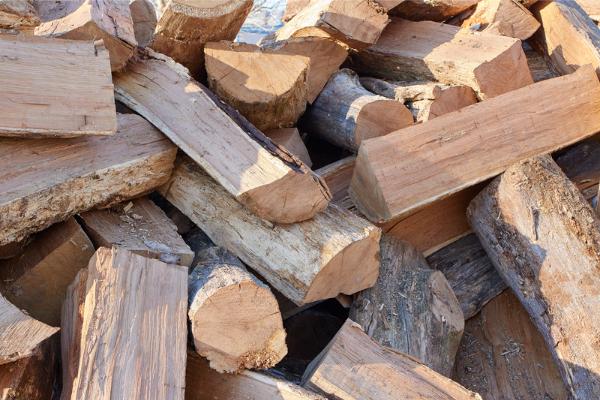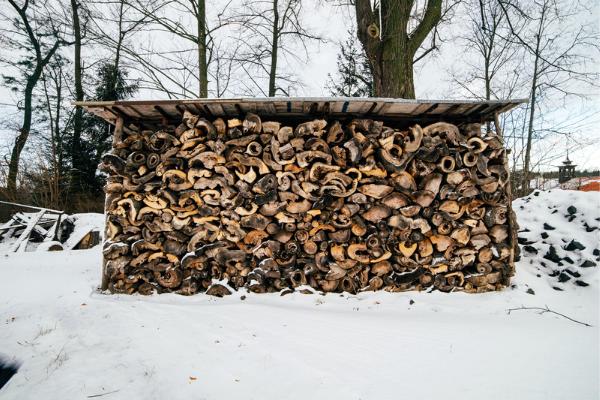Not all firewood is created equal. Some make effective wood for saunas, while others are better for toasting marshmallows. But what wood is used in saunas, anyway?
If you’re looking to fuel a sauna, finding a species that produces controllable optimal heat can be difficult. You want to feel warmth but don’t want to feel like you’re in an oven.
While softwoods can make for good kindling, we’d like to share why kiln-dried hardwood is the most effective sauna fuel you can purchase, and we’ll also show you how to store your supply.
Combine Both Types of Firewood for the Best Results
Many sauna stoves benefit from a combination of softwoods and hardwoods. Softwoods provide the fast-burning kindling you need to get the fire started. Hardwoods are the best heating wood for saunas when you need to maintain a long blaze to keep the heat going.
Softwoods: Best Kindling Wood for Saunas
Softwood species like pine, cedar, fir and spruce make good kindling. They’ll light easily and burn very hot briefly so that you can light your denser hardwoods. As a further bonus, softwoods smell good as they burn, almost like incense.
Don’t use too much softwood, especially the most resinous species, like eucalyptus or aspen, as these will gunk up your stove. A stove with too much “gunk” won’t burn as long and will fill your sauna with too much smoke, which is bad for both the environment and your lungs. Plus, that “gunk” can also cause additional wear and tear on your sauna stove, leading to a decreased lifespan on your investment.
Hardwoods: Best Primary Heating Wood for Saunas
Hardwood species like maple, oak and birch are better for maintaining fires once they’ve gotten started. High-quality hardwoods are denser than softwoods, meaning they’ll take a little longer to light but will burn hotter for much longer.
An added benefit of sturdy hardwoods for your sauna experience? That longer, slower burn doesn’t just mean a longer fire – it also means less stoking so you can sit back and relax!
Use Kiln-Dried Firewood
You have two options when choosing the right wood for saunas: seasoned and kiln-dried wood. The cheaper option, seasoning, reduces moisture content below 40%. Unfortunately, that’s still too high of a moisture content for burning, so the wood will create a lot of unnecessary smoke. Seasoned firewood is also notorious for molding and bug infestations. Yuck.
Thankfully, our kiln-drying process is more effective than the seasoning methods used by other companies. The process consistently brings wood down to 20% or less, which is when logs are ideally ready to burn. Kiln-dried wood creates less smoke, is easier to start and burns hotter than seasoned alternatives.
To accomplish this, wood is placed in our special kilns at 265 degrees for 36 hours (which also makes our process significantly faster than seasoning). While the wood is being kiln-dried to perfection, it’s also being purged of mold, mildew, chemicals or bug infestations so you can breathe easily.

The Best Hardwood Species for Your Sauna
If you’re looking for a particular species to do most of the work, we offer a few concrete suggestions for the best hardwoods with which to fuel saunas:
- Oak: The densest, most common hardwood on the market.
- Birch: Offers some of the highest heat and longest burn times across all available firewood in the United States.
- Maple: Excels at limiting smoke and creosote, so it’s perfect for those most sensitive to the smells of firewood and smoke.
- Ash: Easiest hardwood to get, as it’s readily available from vendors all over the country.
- Cherry: Provides a pleasing fruity aroma when it burns, adding aromatherapy to your sauna session.
- Hickory: Long-lasting flames that burn very clean.
ProCut Firewood offers a wide array of premium kiln-dried wood for saunas – including a unique mix made especially for this purpose! If you’re not sure which hardwood is best for your preferences and needs, we’d be happy to help. Call us at (507) 280-7780 during regular business hours or contact us online.
Maintain the Quality of Your Wood for Saunas
Once your order of pristinely kiln-dried firewood arrives, remember to store it in a way that maintains quality and keeps each log fit for the stove. Let us share a few tips about storing your sauna wood:
- Make sure your logs hang onto as much dryness as possible. By keeping them in a humid or wet environment, you can ruin the kiln-dried firewood by increasing the log’s moisture content. Instead, store your wood for saunas in a dry place until ready for use.
- Avoid stacking firewood on the ground. It should be on either a pallet or concrete. As you stack each log, leave enough space to allow for airflow. You don’t want the ones at the bottom to lose their dryness.
- Remember to throw a loose tarp over the firewood. Unless your firewood is already beneath an awning, it needs shelter from the elements. Emphasis on “loose!” You don’t want your tarp to trap moisture.

Enjoy Kiln-Dried Wood for Saunas in the Twin Cities Region
Saunas should be as enjoyable and relaxing as possible, so you shouldn’t settle for anything less than kiln-dried hardwood. Using this premium wood means you’ll have hotter, longer fires that produce less smoke and creosote – with zero risk of bug infestations or chemical inhalation.
For decades, ProCut Firewood has provided kiln-dried hardwood to sauna enjoyers all over Minneapolis, St. Paul and beyond to towns like Prior Lake, Stillwater and many more. To start your order, please call us, email us or fill out an online contact form.
Editors Note: This blog was originally published in May of 2023 and updated in December of 2023.







